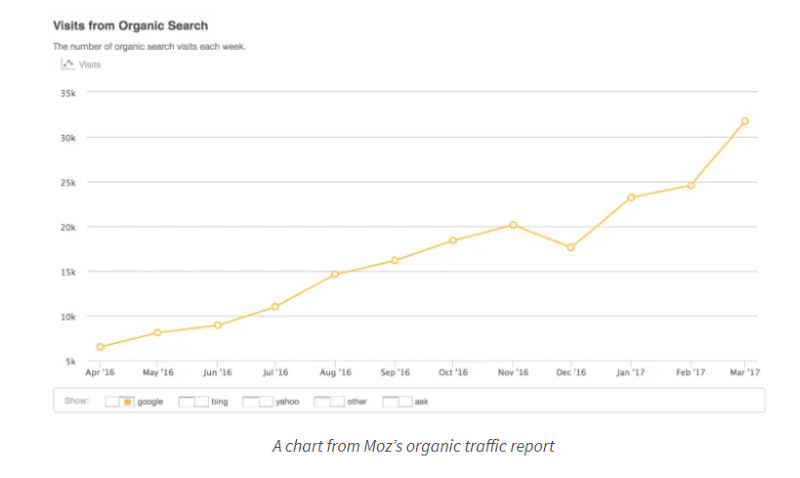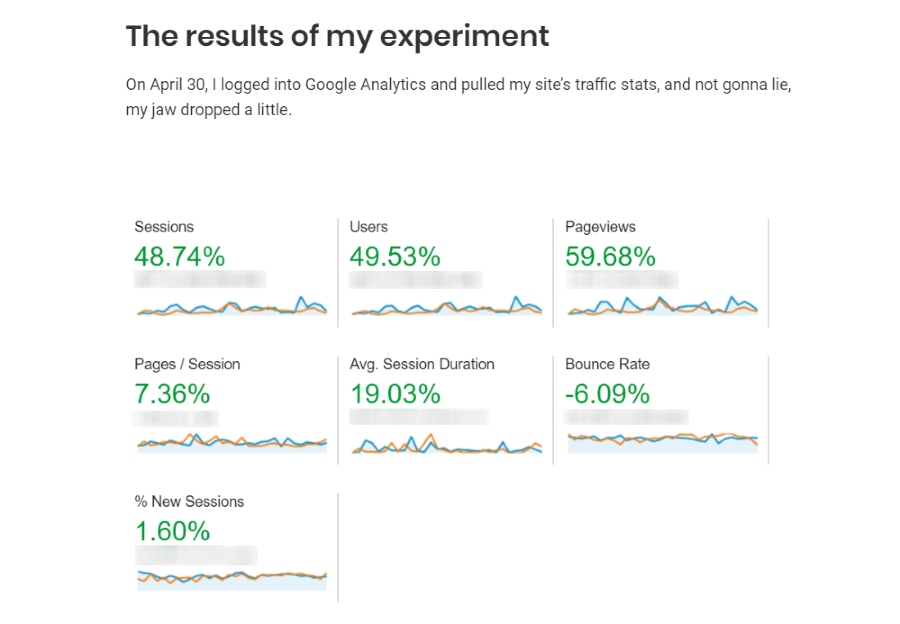06 Jul

According to the leading blog hosting site, WordPress, there are over 40 million posts published in a month. Imagine that. 40 million pages in just 30 days. No wonder bloggers or marketers are competitive because they want to stand out and skyrocket that blog traffic. Even with that number, it’s still possible to get your blog noticed.
The process isn’t easy, but if you follow these ten proven steps to increase your traffic, you can get a high ranking on search engines.
1. Identify Your Blog’s Strengths and Weaknesses
So, you’re finally thinking about seeing your stats spike on your blog. Perhaps you’ve seen the case studies floating around, saying, “here’s how we increased our blog traffic.”
I must warn you that it can get pretty tough, especially when you have competitors vying for the top 10 positions on Google. Before you take action, you must look into your current blog status. It can take time, especially if you’re monitoring and analyzing blog traffic day in and day out.
Besides, it’s the logical way to look at it. You don’t want to dive in headfirst into a strategy if you don’t know what you want to improve or put aside. This will put you at a disadvantage. It’s going to get messy, and you won’t be able to measure your success. I’m telling you this now. Your competitors are measuring their blogs. If you see them often on search results, they’re doing something behind the scenes.
For instance, some companies would go to marketing or SEO agencies to handle their challenges. It’ll be easier for them to leave it to the pros. However, if you have a reliable marketing team, then you need to look at your numbers. Even if you don’t have a team, that’s fine too.
Maybe you notice that the lines fluctuate. Sometimes, it’s high, sometimes it plateaus. That’s normal, especially when you’re still adjusting or when you haven’t the faintest idea of how to drive your blog traffic.
Ask yourself these questions
- What current strategies do you have in place for promoting your blog post?
- What do you think you should shelve, and what are things you could try to raise the numbers?
In this manner, you can start devising your plan to get that coveted spot at the top.
2. Craft a Plan
Here’s where you’ll get detailed.
Planning plays a crucial role in getting blog traffic. Since you’ve identified your challenges and strengths, you need to organize a plan. It’s how you can execute your strategies in an organized manner. That way, you get meaningful results at the end of this. Plus, you get a better sense of how you’re or your business is faring.
In here, you’ll determine where and how you’ll execute your plan.
A general plan would involve a content audit, keyword research, blog optimization, and promotion.
3. Conduct a Content Audit

Maybe you’ve posted old blogs before that did well or made a decent amount of blog traffic. You might want to bring them back. It can determine which posts you can keep and delete. This way, you’re decluttering your blog of those posts that are costing you visits. Plus, you’re making room for the new ones you’ve optimized to get those clicks.
Hunter Branch wrote on Wordstream when his agency did a content audit for their client. What he did was to categorize blogs into a revamp or redirect. According to Branch, he chose blogs that needed revamp because they hold value (keyword-wise) and included insights.
Meanwhile, they had some for redirection because it didn’t hold any SEO-potential. Some posts were even left unpublished.
4. Do Your Keyword Research
An essential part of getting blog traffic is finding the keywords that will help you rank.
Your first step involves researching your keywords. But before that, did you ever establish what keywords you wanted to rank for a while you’re blogging? If your answer is no, then it’s time you start researching your keywords.
Okay, for your keyword research, it doesn’t have to get complicated. You just need a set of tools that’ll ease up the process. Some of them might require you to pay; some have limited features.
Shocked that some keyword tools would ask you to pay after an x number of days trial? Relax, there are FREE tools if you’re thinking of spending your blogging expenses somewhere else. Here are five free tools to start:
- Ubersuggest
- Answer The Public
- Keyword Surfer
- Soovle
- Google Trends
Here’s what Moz advises:
Know your audience
Who are you targeting for your blog? Sometimes you’ll have to find your specific audience for your blog. Let’s say your focus is on gardening. Make sure the focus lies in those who want to start the hobby or with experience.
Use long-tail keywords
According to Moz, these keywords are very search-specific. Yet, somehow they still get conversions. Why? The searchers know what they already want, and if you can provide them that, you’re a sure winner.
Utilize keywords to your advantage
What does this mean? Moz provides three ways you can do it. One is to research your competition’s keywords. It’s a clever trick that many marketers do. If their competitor’s ranking is high for a specific keyword, you might want to consider it too. Don’t let them hog the keyword for themselves.
The second is used by season. This is helpful when you want to get into the minds of your readers during the holidays. Best if you do it in advance.
Finally, you can go for local keywords. You want to start small, and local keywords can help you extend your reach in your area. This means you might want to use wordings specific to that area too. That’s how you can capture your audience’s attention.
Once you’ve gone through the challenging task of finding the keywords you want, you should know how to use them properly.
5. Be Strategic On What to Post
You don’t want to write for the sake of writing something. As part of your plan, you want to try posting out of necessity. Many would suggest creating an editorial calendar to schedule posts in a week, month, or year.
Venngage recommends that you write posts meant to solve your reader’s issues. That’s a great strategy because you want to be the go-to blog for your readers. Let’s say you’re running a travel blog, and based on your research, people search how to pack light or where to find cheap accommodation. That’s how you can write posts and address their concerns.
Let’s say you have blogs that may have solved previous concerns. What you can do as an alternative is think of a theme. For example, you might want to publish posts about homemade recipes involving flour. That way, you can focus on ranking for that specific keyword. That’s how Karola Karlson did to raise her organic traffic from 1.6k to 31k visitors in 20 months.

Once you’ve decided on what to write (and say you’ve written something), make sure to optimize your posts. Otherwise, you won’t get the clicks you need.
6. Optimize Your Blog Posts
So when you write blog posts, here are some things to remember in optimizing your blogs:
Incorporate keywords on the blog (without stuffing keywords)
As Jessica Foster shared in Search Engine Land, there’s no specific number of keywords for you to get your blog noticed. However, you have to be careful not to go overboard since it can damage your SEO efforts if you stuff keywords. Make sure you have a good keyword ratio to your word count. That way, you balance everything out.
Use header tags (and put keywords on the headers, if you can)
You want to add header tags, such as H1, H2, H3, and H4 because it’ll give your blogs structure and help readers scan your blog better. Search Engine Journal recommends you put your keyword on the header tag because when Google indexes your blog, it can help provide authority.
Add keywords on the images
You should add images to your blog posts. Orbit Media finds that those who add pictures on their blog reported they get 2.5x better results than other bloggers. It means that you should add images because they can help break up texts and get shared. However, an overlooked part of optimization is the alt text for images.
According to Hubspot, if you add an alt text, you can rank on search engines. So, you can do this in two ways. One is to describe the image as it is. The other is incorporating the keyword on the page. This helps Google to search for images. Your blog might get found in a search about “dog smiling” even when the post isn’t remotely related to dogs.
Use a headline analyzer
Part of optimizing your blogs is to write a headline that captures people’s attention. Sure, you’re incorporating the keyword, but that isn’t enough to make your reader click on the article. Instead, use a headline analyzer tool to ensure that you get a great viral headline.
Write a meta description
Lastly, you need a meta description. A meta description is a snippet about your blog post, and it can make readers click on the blog. Plus, Neil Patel says this is so Google can identify your blog post as a credible source and help you rank. Make sure that you also incorporate your keywords here. Plus, ensure that it’s engaging enough that it’ll contribute to your organic traffic.
7. Update Old Posts
During your content audit, you might have left some old posts that are evergreen. These posts remain relevant because it still applies regardless of the year or situation. Once you’ve written your new blogs, you can proceed to update and optimize your blog posts. This allows you to save time on writing a new one from scratch and improve your new blog post.
Check out how Live Pro did it for their client. According to the agency, they don’t create a new blog for an annual event, for example. They update the old one that helps them keep track of the traffic from the post. They were able to increase the traffic through referring pages.
8. Promote Your Posts
Don’t expect to have your blog posts sit on your website and people clicking on it once you hit publish. Even if you have a plan in place and have a decent amount of blog traffic coming in, promoting your blog posts can help boost your numbers.
Tip: Sign up on Google Search Console. Captivate Designs recommends that you can index your posts faster. It means your blog will appear much faster rather than wait for it to happen naturally (meaning, it could take a week for it to appear on search engines).
Here’s what you can do:
Post on Social Media
The best way to promote your posts at a low cost is to publish a link to your blog post on social media. On Twitter, for example, you can simply post a link on your Twitter account. But it doesn’t stop there. You should ensure that you’re using keywords on your tweet as well. This may help you get likes or retweets from those who follow those keywords. The same practice goes for Facebook and LinkedIn posts as well.
Check out how Tami Brehse used Twitter to her advantage. She posted 20 of her blogs, created three different tweets for that, and scheduled those tweets twice a day for the whole month. She scheduled it at different times and monitored them. Ultimately, she earned over 50% of traffic, 31% of those came from Twitter.

If that’s not working out for you, you can even try publishing it as ads on social media. It’s another way you can widen your reach and have more people click on your links. It’s a widely practiced approach, and if you have some moolah to spare, then go for it. However, Ahrefs says you need to be mindful when using social media ads, especially if you’re not converting leads into readers.
Send Out Email Newsletters
On your blog, do you ever ask your readers to get updates through email? If so, that’s already a good start. For one, you’re capturing leads in the process. This means you can use those emails (provided they signed up, and they consented to do so) and start your email newsletter campaign.
This allows your email subscribers to share the word with others, and who knows your audience might become your promoters.
9. Engage and Become Credible
Hold on, shouldn’t becoming a credible source be a given when you’re writing and optimizing your blog? It doesn’t stop at writing your blog.
You need to get yourself out there and promote some more (aside from the known ways to do so).
Some other things you can do are:
Leave comments on blog posts
Sometimes, you have to leave a comment on a related blog. A common example of what marketers or bloggers would do is go on list posts and share their site. That way, when people scroll down to the bottom of the page, they can find other alternatives. Who knows, if your blog is something worthy to be added on the list, the writer can add yours there.
Go on Reddit or Quora
Before you post anything on Reddit, make sure you read the subreddit rules. Sometimes, there’s a no-promoting rule, so you can’t exactly post your blog there for no reason. You can be kicked out or banned, and you don’t want that. A great way to promote your blog is when someone asks for recommendations or how-to’s on some topics. There, you can promote your blog or yourself and direct them to your site.
Meanwhile, for Quora, you can promote yourself, your company, or your blog there. Make sure that you’re answering a question that’s relevant to what you’re going to promote. You can write a snippet and lead a curious viewer to your blog. For added credibility, make sure that you have a profile with your information. That way, you’re seen as a legitimate source.
Write a guest post
Sujan Patel wrote in a Forbes article that you could also write guest posts on blogs. Then on the blog itself, you can backlink to yours. This amps your credibility, and it can help generate more traffic on your blog. This gets you more recognition from viewers of the other website, and you might generate more visits and clicks from them.
10. Monitor, Measure, Improve, Restart
Once you’ve done all of these, it doesn’t stop there. You see, if you want to maintain the impact you’ve gotten over the past few weeks or months, you don’t want to stop that momentum. Sure, these are surefire ways to get blog traffic, but you might want to make modifications to your current content strategy.
It’s a common practice that even you shouldn’t set aside. It’s how you can assess if the process is working in your favor, you might need some tweaks, or throw it away completely. At least this time, you won’t have to go back to square one because you’ve got some building blocks. Plus, you know how to build it and give you more blog traffic along the way.
Final Thoughts
Increasing your blog traffic can become a tedious process. It may even take a long time to see results. It can become challenging because you’ll pour a lot of work into this. However, if you want to get your blog noticed, you’ll have to follow these steps. It’ll all be worth it.










